Airfix 1/24 Peugeot 905 review
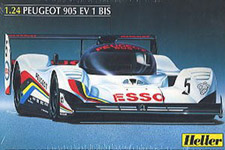
| 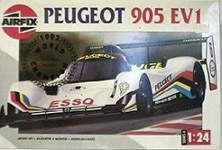
| 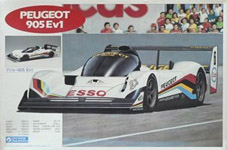
| 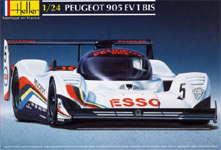
| 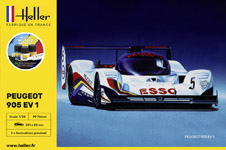
|
| Heller 80718 (1992-) | Airfix 06419 (1993 to 1996) | Gunze Sangyo GX-419 (1993) | Heller 80178 (2011-) | Heller 56718 (2021-) |

| 
| 
| 
| 
|
| Heller 80718 (1992-) | Airfix 06419 (1993 to 1996) | Gunze Sangyo GX-419 (1993) | Heller 80178 (2011-) | Heller 56718 (2021-) |
Heller issued a 1/24 scale model of the Peugeot 905 in 1992, followed by an issue of the same model by Airfix in 1993, and the same year it was issued by Gunze Sangyo. Among builders of sports car models, this kit is often mentioned as a model that is very difficult to build, and actually not worth the trouble. For example, Bill Via commented: "The Heller 905 EV1 Bis kit is the absolute WORST kit I have ever seen in my 30+ years of building kits. Out of 1000+ kits I've built during my entire life, it's the only one I simply could not fix and ended up throwing it away, not even saving anything from the box for my parts stash. Not only should this kit be shunned by moderate builders, but folks who can scratchbuild should leave it alone as well. I've had two of them (the purchases separated by 5 years) and the only good thing about them is the boxart." Bill described the following problems of the two Heller kits that he owned:
Every flat panel is warped (chassis pan, body coverings)
Every curved panel is warped (driver greenhouse, engine coverings)
Parts not symmetrical: left side parts are smaller, shorter, more curved than right side body parts
Angle of chassis pan incorrect to angle of all other body parts, you cannot close the body if you build it off the chassis pan
Tires were rectangular in cross-section, almost a perfect 90 degrees from the tread to sidewall transition. Opening is too small to fit over wheels
Glass is undersized for the opening in greenhouse
Decals exhibit Moire effect and fall apart when introduced to water
Bill's review confused me greatly, since my Airfix kit didn't look too bad, and dry-fitted reasonably well. It's not a great kit, but it looked far from unbuildable. It took a long time before it became clear where the confusion originated. It appears that there is a large quality variation with this model, both in the Heller and Airfix packaging, and that this can be attributed to the injection molding process. This process has lots of variables, such as mold temperature, material temperature, pressures at several stages of the process, and injection and cooling times. Mike Kendel commented that problems 1 through 6 all could be caused by the injection molding variables. Even with a perfect mold, the wrong set of variables can produce bad products. Back in 1992/1993 when this kit came out, Heller did all the molding of Airfix models. It can therefore be assumed that both the Heller and Airfix versions were made in the same injection molding plant. Possibly the kit's molds required a very specific set of settings, and that these were not always adhered to. It's most likely that Heller produced good and bad batches of this model.
In the combined 1993 Airfix/Heller catalog, the Heller part contains some information on the development of this model:
On the 15th of October, 1992, the injection moulding machines in our factory produced the first set of parts for the 1:24th scale Peugeot 905 EV1 Mark 2 [French text says EV1bis]. This vehicle is the very latest state of the art in sports racings cars and it shows that we, at the Heller company are always in the forefront of the model industry with new kits.
3 days later, on the 18th of October at the Magny Cours race track, Mr Jean Todt, Director of Peugeot Sport, was presented with the first completed model.
The initial idea to produce a model kit of the car to final production took 7 months, an amazing number of hours had to be dedicated to the project to get every detail correct. 4 visits to the Peugeot Talbot Sports factory were required by our research team and then 800 hours of computer aided design to produce a full range of drawings from the rear spoiler to the v.10 engine. It then took another 3,000 hours to manufacture the mould tool of 95 parts, which includes 41 for the engine alone, to the highest standards of precision.
Each year we endavour to produce better and more accurate kits so that our models become "always true to life".
I shot the following photographs of my dry-fitted model to show that points 1-3 and 5-6 don't apply to my Airfix kit. Bill Via commented: "My two examples were NOTHING like the photos of yours".
| The monocoque has the front suspension attached, and that makes sanding after assembly difficult. I removed the upper and lower wishbones from the monocoque parts, and put pins in the wishbones for easy reassembly. Then I assembled the two parts that form the lower side. | 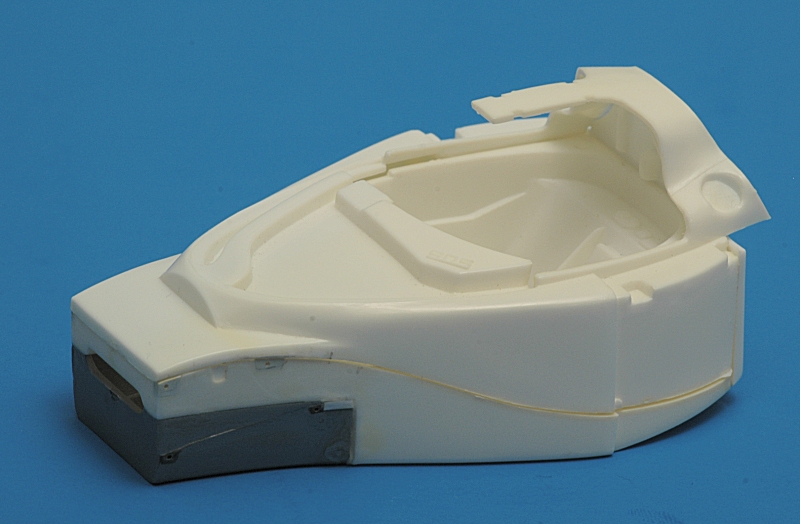
|
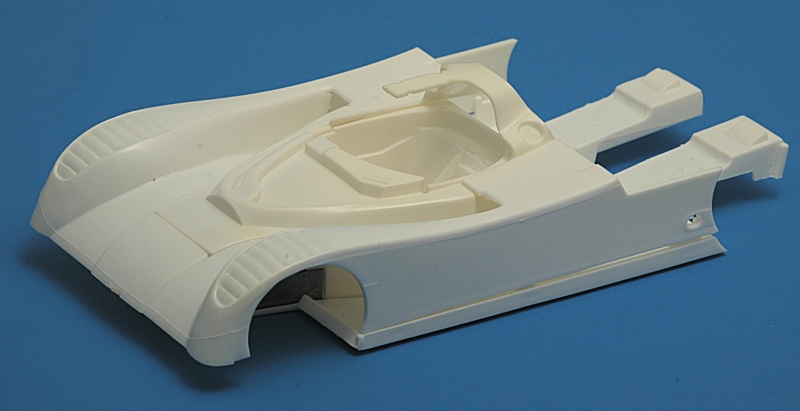
| The main bodywork fits relatively well without tape. Closing the gap between the sides and the floor deforms the floor slightly. The monocoque could be slightly too tall (point 4), so maybe this can be solved by removing around 1 mm of the monocoque's height. As far as I can see, the engine will accept this drop too, since there is some space between the sump and the floor panel. The body has substantial mould lines on the sides. |
| Some gaps exist between the monocoque and the bodywork. It looks like the monocoque is pushed to one side of the opening, which will require some fine-tuning.
The louvers on the front fenders are not too bad, but I'm pretty sure they extend to far forward. They are also set too deep: they should extend slightly from the fender contour in side view. Subsequently, in side view the front fenders look flattened in the louvre area, it's not a continuous curve. That cannot be corrected if you want to retain the louvers, but if you're building a Le Mans car without louvers, you should build up that area. Similarly the wheel opening is not round but flattened at the top. The rear edge of the wheel opening must be rounded off. | 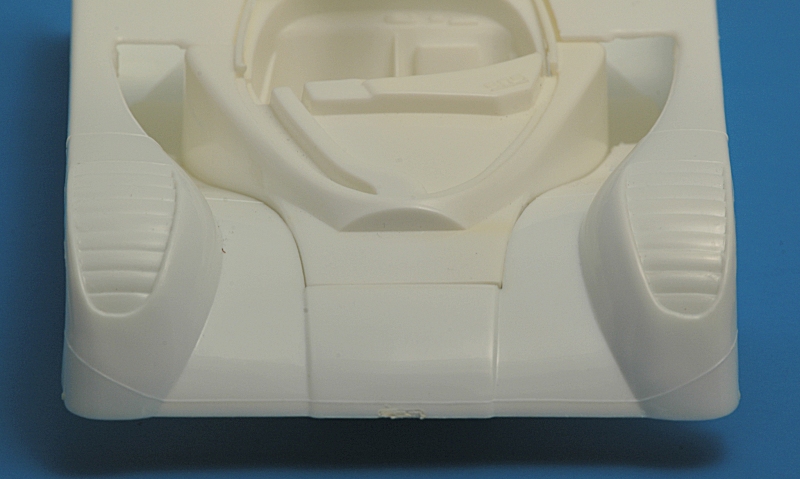
|
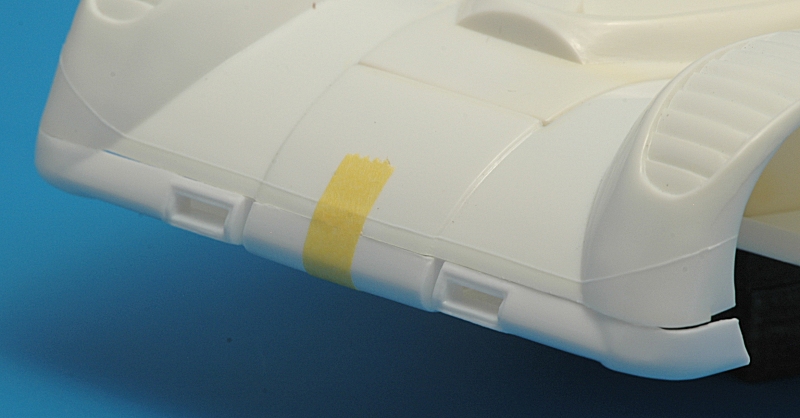
| The lower nose part (#14) was described in one review as being 2 mm oversize on both sides. Yet it fits relatively well here, but it does require a cut somewhere to fit properly. |
| The rear bodywork fits reasonably but could use some fine tuning. A closed engine cover will help immensely, and will save a lot of time detailing the engine bay. | 
|
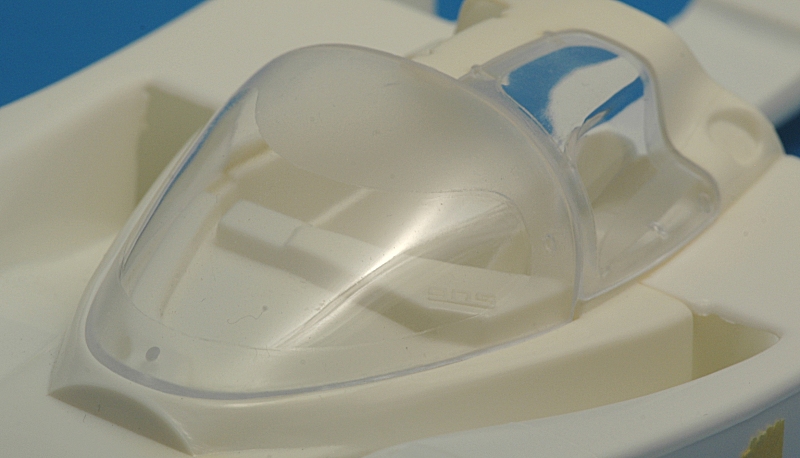
| The transparent parts fit well, except for the door window, which shows a step on the rear side. |
| The engine air inlet also fits well even when just dry-fitted, contrary to complaints by other modelers. The key might be that the engine is to be glued against the back of the monocoque, and not to the floor panel. The latter causes a small drop of the engine. | 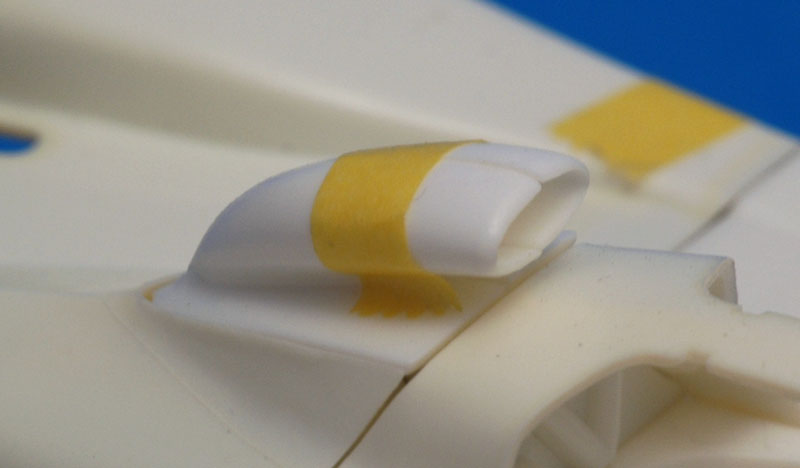
|
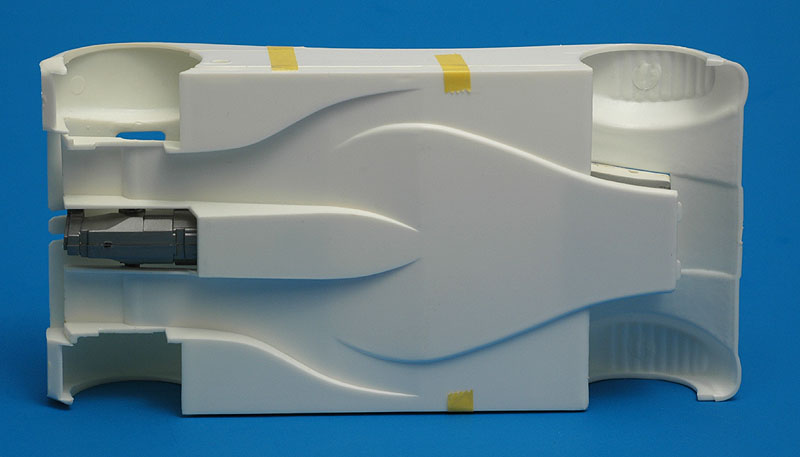
| The floor panel seems to lack a cover for the gearbox and some vanes in the tunnels. Unfortunately there are very few photos of the lower side. |
| In 2018 I was able to study the underside of a 905 Evo 1c jacked up to hip level. I assume the Evo 1c floor panel was the same as that of the Evo 1bis. It turned out that the pear-shaped area between the front axle and the start of the tunnels does not exist - the floor panel is completely flat there. The easiest solution is gluing 1.2 mm plastic card in the 'raised' areas, down to the rear axle. At the sides, there are horizontal strips that stick out of the car's plan view a few centimeters. The shape of the venturi tunnel entries is wrong too: it should be one continuous curve instead of the one shown that changes direction (for lack of a better description). I've sketched a rough drawing of these details. The whole floor is yellow aramid / Kevlar fiber, with the exception of the rear 80% of the tunnels. There are skid blocks in several places. | 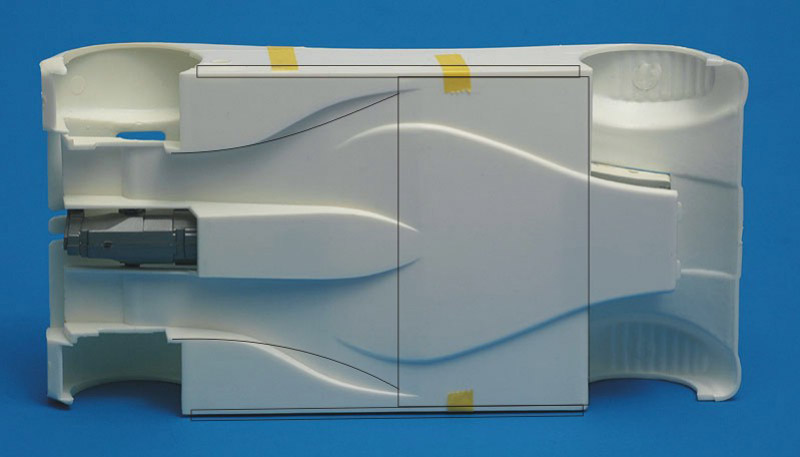
|
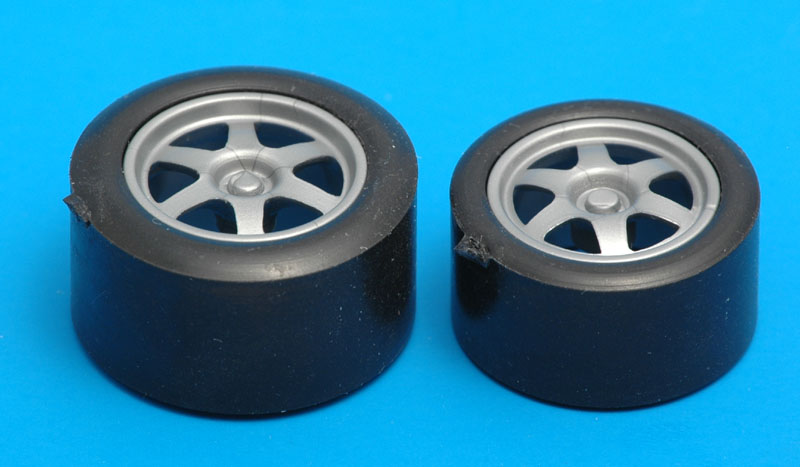
| The wheels fit perfectly in the tires, but lack a locking nut. The tires are glossy and feel like plasticised plastic. Wheel sizes, when compensated for the tire bead retaing lip of an estimated 1.6", are 17" for the front and 18" for the rear. My references 'World Sportscar Racing '91' and 'World Sportscar Racing '92' both list 17" front and 18" rear. But I've learned that books like these are not the absolute truth.
I found some of my own photos that showed tire sizes, but it's a rather incomplete picture:
Johan Brusefält investigated the subject too, and concluded that during the 1991 and 1992 Group-C seasons only 17" front / 18" rear wheels were used. I can accept that conclusion, and work with these wheel sizes. |
| A good way to deal with tire problems is to give the tire a flat spot at the sprue attachment point. This avoids the car 'standing on its toes' impression and eliminates the sprue attachment. The tire can be scuffed with Scotchbrite, which transforms the shiny plastic to a rubber color and texture. After this the tires actually look pretty good. However they now attract dirt like crazy! | 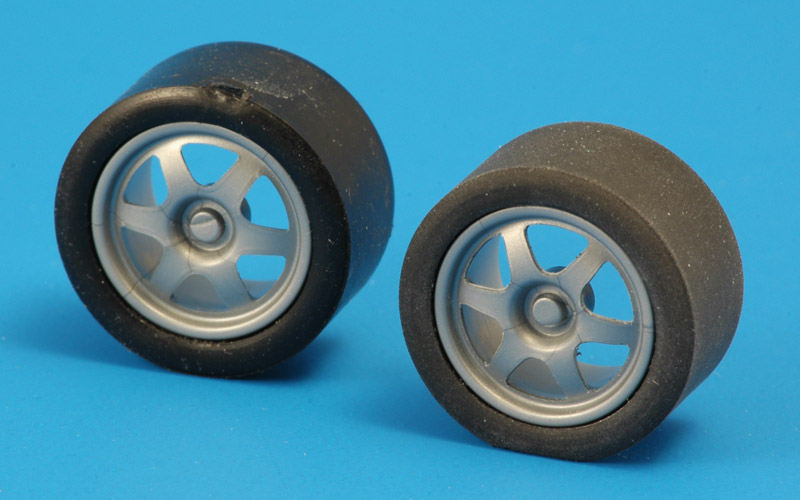
|
There is some debate whether the model represent an 'Evo 1' or 'Evo 1 Bis'. The problem starts with the question whether there ever was an 'Evo 1'. The book 'World Sportscar Racing '91' from late 1991 calls the model introduced at the Nurburgring race on 18 August 1991 already an 'Evo 1 Bis'. This suggests an 'Evo 1 sans suffix' was not raced. The model manufacturers contribute to the confusion by calling the same model 'Ev 1' (Airfix, Gunze Sangyo) and 'Ev 1 Bis' (Heller) on the box top.
In 1993, parts of the never-raced 905 Evo 2 were fitted to the Evo 1 bis, including transverse gearbox, rear suspension, bigger tunnels. The bodywork bulge around and behind the engine became larger and rounded. The rear brake inlets moved inboard a bit. The exhausts were rerouted from the sides to the venturi tunnels. This version is sometimes referred to as the 'Evo 1c'.
However, the designations that Le Mans Miniatures uses for their models is 'Evo 1' for the 1992, and 'Evo 1bis' for the 1993 model. Heller started producing their kit in 1992, which includes decals for a 1991 car, and the box says 'EV 1 BIS'. That shows that the 'Evo 1 bis' designation was already used in at least 1992, and not from 1993 on.
Based on this information, I believe the model correctly represents an 'Evo 1 bis' version.
The kit has some problems, and has room for improvements:
To my eye, the bodywork looks too square.
at least around the front and rear wheels, the transition from side to top should be made more rounded.
at a Spa Classic event, I did some rough measurements, by eye. The edge radius of the center body is some 20-25 mm. Starting at the panel line between the center body and the front fender, the radius increases to around 50 mm in the middle of the front wheel opening. It then increases further while transitioning into the nose shape.
I think, but did not measure on the real car, that both front and rear fenders should be more rounded on their top sides.
the 'engine bulge' on the rear deck is too flat at the rear. It should be taller and more defined.
The body has raised lines where body panels meet, these are best scribed in
The louvers on the front fenders start too far forward and stop short of the real position, and they are placed slightly too low in the fenders. This problem is difficult to solve, maybe it can be done with the aid of a second model. Alternatively, some photos show a blanking plate instead of louvres (Le Mans 1992 and 1993 at least)
The inlet ducts that lead to the radiators on either side of the cockpit taper in width towards the rear. However their width should be more or less constant, and approximately from the dashboard aft, the outboard walls should be moved outwards, dipping under the upper bodywork. Luckily the bodywork is quite accessible there to perform the required cuts
As described above, the fit of the body is supposedly improved by removing 1 mm from the monocoque height
Reportedly, the rear wheel wells need to be enlarged to clear the rear tires. I checked it on my model but didn't see a problem there
The rear wing endplates feature a diagonal texture on the inboard sides, and a slight sandpaper structure on the outboard sides. They probably try to represent carbon fiber, but do a bad job. The endplates are better sanded flush and decaled with carbon fiber decals
The spokes of the wheels have a half-round cross-section, which makes them appear infinitely thin from the outer side. The real spokes have a rectangular cross section.
The tires look pretty bad: shiny soft plastic with sprue attachments that leave unrepairable traces. There are two ways to solve the problems:
A good way to deal with tire problems is shown above in the photo section
Some shopping in Tamiya and Hasegawa Group-C kits will undoubtedly yield suitable replacements. The rear tires of the Tamiya Toyota 88CV fit well and are only marginally larger. The front tires of the Hasegawa Nissan R89C fit well. But maybe there are better matches to be found
I checked the fit of the kit tire in the wheel opening, and the wheel/tire looked a bit too small. Or maybe the wheel opening should be reduced by gluing a strip of plastic around the edge.
The front wheels are not made to steer, leading to a rather static appearance
The engine is a rather basic representation, and some essential suspension parts (springs/dampers) are missing. The engine bay needs a lot of detailing before you can park the model next to a Tamiya model
The engine air inlet is sometimes reported to be positioned too low on the engine, leaving gaps with the bodywork. Yet again, a dry-fit on my model showed no problems. Maybe the builders with problems ignored the pins on the front end of the block, that attach to the rear of the monocoque, but instead glued the engine to the floor
For a car relying heavily on ground effects, I find it unlikely that the floor is cut away in the gearbox area. Although 'under the skirt' photos are rare, I found one that shows the gearbox to be covered by the floor. But of course that could also be a later modification. Inside the tunnels, a vertical strake (slight curved in plan view) is missing. It is easy to make. 'Racecar Engineering' Volume 2 Number 4 from 1992 has an article ('Last of the Longtails') on the Peugeot 905 with an aerodynamic analysis
A building tip is to attach the exhaust pipes to the engine before gluing the engine to the monocoque
The model has no headlights, which is correct for the decal options of the Airfix version (Magny-Cours 15 September 1991 and Magny-Cours 18 October 1992) with different color stripes and numbers. The Heller version only has the decals for the 1991 race. The 1992 car didn't have side exhausts except at Le Mans so these need to be removed and the exhaust pipes re-routed to blow the tunnels from the outboard side (see Gurney Flap link)
The colors of the Airfix decals are rather subdued
The many red arrows on the decal sheet point to quick-release fasteners that can be represented by small photo-etch parts (or similar). All bodyworks fasteners are recessed.
An electrical cut-off handle can be added at the right-side rear of the windscreen
Aerials on the cockpit roof can be added
Profil24 produces two resin 1/24 905s: 1992 Le Mans Evo 1B (P24004) and 1993 Le Mans Evo 1B (P24005). They are curbside models without engine details and a one-piece body. They feature headlights and the front fender louvers are closed but positioned correctly. It is reported that the model is based on the Heller/Airfix kit, but a couple of parts are integrated and some are changed to meet new specs. For example, the 1993 version has an extended bulge on the engine cover, the exhausts are deleted from the sides and the rear brake inlets are closer to each other. It is reported that the Profil 24 models are more accurate than the Heller/Airfix kit. One improvement that I see is that the main inlets are wider, and partly go under the top of the body. Also, these models have details of the pins and clasps that fix the removable bodywork parts on the 1:1 car. Johan Brusefält made the following photo that compares the Heller/Airfix kit (left) to the Profil24 (right) kits.
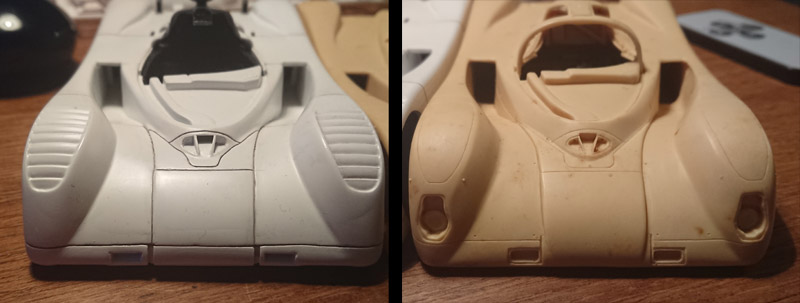
Spark / Redline issued a 1/24 die-cast Peugeot 905, the Le Mans 1992 winner (catalog number 07-2008). This model is based on a Le Mans Miniatures master.
Hachette Collections from France also issued a 1/24 die-cast Peugeot 905, again the Le Mans 1992 winner (catalog number G1Y21004). This model has headlights, that could be useful for a model.
Seven Evo 1 chassis were built according to Martin Krejci's chassis number list. Museum examples are reportedly to be found here:
Peugeot Museum in Sochaux, Peugeot 905 Evo 1 bis (Le Mans winner 1992), Peugeot Evo 2. Chassis numbers EV12 and EV 17 are reported.
Musée des 24 Heures in Le Mans. Peugeot 905 Evo 2
Musée National de l'Automobil in Mulhouse. Peugeot 905 'sans suffix'
Manoir de l'Automobile in Loheac (French Britanny). The website doesn't show or list a 905 however, possibly the report is not correct
Around 2011, some cars appeared on the tracks again, for classic racing. The following was compiled from limited data, so it might not be 100% correct.
Rupert Clevely owns and races chassis EV15 and EV16
Possibly one of the above was sold to a new owner in 2013, and transferred during the classic race at Spa
AGS on the Castellet circuit owns EV13, and it is available for driving. Possibly it was sold on.
Ecurie Europe in France owns three, that can be seen Cranck and piston page or Drivr page. They are the Baldi/Alliot/Jabouille #1 Le Mans 3rd 1992 & 1993 car, the Dalmas/Warwick/Blundell #1 Le Mans 1992 winner, and a third one (#2)
EV14 was offered at an auctioned in 2009, but the reserve price was not met. I saw EV14 racing at Spa in May 2016.
Decal options of the kit-supplied decals are:
Heller has decals for the #5 (Alliot/Baldi) and the #6 car (Dalmas/Rosberg) cars in the Magny-Cours race on 15 September 1991
Airfix has decals for the #5 (Alliot/Baldi) and the #6 car (Dalmas/Rosberg) cars in the Magny-Cours race on 15 September 1991, and the #1 car (Dalmas/Warwick) in the Magny-Cours race on 18 October 1992
The decals in the Gunze kit appear to be identical to the Airfix decals, but maybe they were printed by another decal printer?
Aftermarket decals are provided by four suppliers:
Shunko sheet SHK-D120, covering 1991-1993. Beautiful printing, colors are much more vibrant than the Airfix decals. It sold out quickly, and a reprint was made in autumn 2013
Patto's Place for 'Pugeot 905 EV 1 Le Mans' (sic) in various scales
Indycals for '1991 Peugeot 905 EV 1 BIS' in various scales, issued in 2017
Museum Collection for 1992 and 1993 Peugeot 905 (seet D882), probably issued in 2018
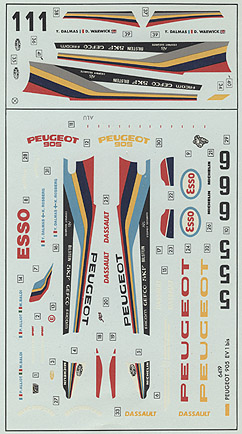
|
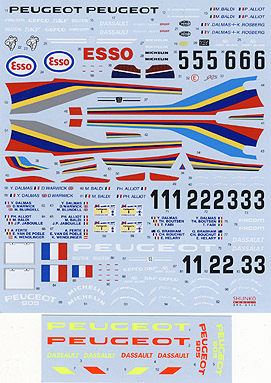
|
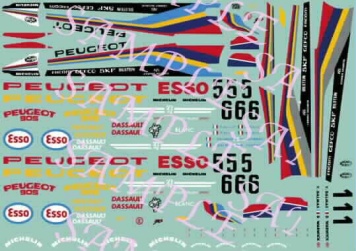
|

|
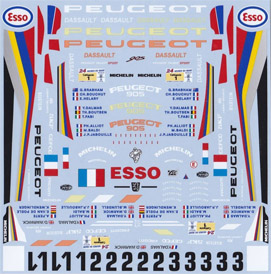
|
| Airfix | Shunko | Patto's | Indycals | Museum Collection |
In 2019, the first 905 aftermarket accessory appeared on the market:
Brusefält Model Parts on Shapeways offers replacement wheels, that have spokes with a realistic thickness and a much better central locking nut
Peugeot 905 EV 1 bis (Heller, 1/24 scale) finished model by Thomas St on the MCM forum
Peugeot 905 EV1 finished model by Rich Chernosky on the MCM forum, with turned front wheels
Peugeot 905 EV1 BIS - 1/24 finished model by Joao Alfredo on the Automotive Forums, with open louvres over the front wheels. Also shown on the F1M forum
Peugeot 905B - 1992 Le Mans winner by 'tmathew1us' on the MCM forum. This model is the first I've seen with headlights and closed wheel arch vents.
Peugeot 905 evo 1 bis / Heller 1/24 build report by 'gderoo' on the F1M forum, and the finished model
Heller Peugeot 905 build report by 'Lathafummi' on the Automotive Forums
Heller Peugeot 905 build report by '123yokomo' on the Automotive Forums. Similar reports were posted on on the Model Cars Magazine forum, both in-progress and photos of the finished model
Heller Peugeot 905 build report by 'f512m' on the Caradisiac forum, very nice build (translation)
Airfix Peugeot 905 by AntPhillips on Britmodeller forum
Heller Peugeot 905 by Steffen Hübner
Heller Peugeot 905 on Modelclub Greece forum
Heller Peugeot 905 by 'valie' on De Paddock forum
Heller Peugeot 905 by 'cedA4V6' on French Forum-Auto forum, 30 pages so far (translation)
Airfix Peugeot 905 by 'Spad' on the 'Locate and Cement' forum
Heller Peugeot 905 by Rene Ebstrup on the MCM forum
Heller Peugeot 905 in progress by 'ScalemodelMadnessDan' on Britmodeller, plus the result
Museum Collection Peugeot 905 walkaround with 138 photos
Classic Cars July 2009 (Jaguar E-Type on the cover) with a story about the history of chassis 1.4